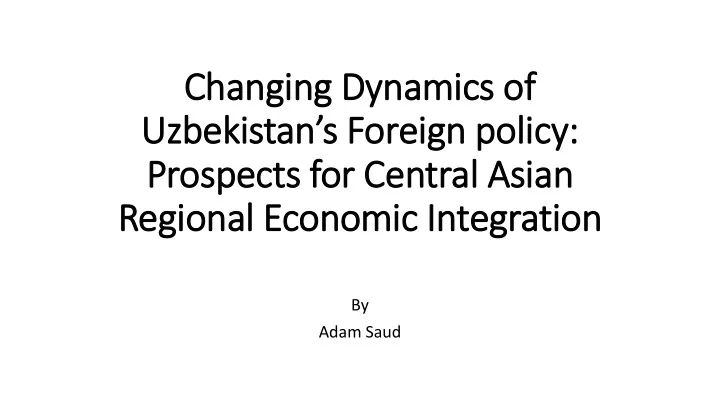

Changing D Dynamics o of Uzbeki kistan’s F Foreign p policy: y: Pros ospects f for Central A Asian Regional E Econom omic I c Integ egration on By Adam Saud
Introduction • Shavkat Mirziyoyev in his first address to the Parliament ( Oliy Majlis ) in May 2017 stated that Uzbekistan needs a ‘modern’ foreign policy. • Visit to all Central Asian states under the policy of “Central Asia First.” • Landlocked region. • Dependency on Russia and China for exports. • Reserved Karimov and active Mirziyoyev. • Attended CSTO meeting. • Shown interest in EurAsEc.
Background • Fluctuating foreign policy of Uzbekistan. • Ethnic tensions in the region. • Water issues. • Border conflicts. • Extremism and terrorism. • Uzbekistan’s conflict with all the neighboring states.
Map of Central Asia
Economic Realiti ties of Centr tral Asia • Next Middle East. • TAPI and Trans-Caspian Pipelines. • Cotton production. • Light machines, automobiles, Pharmaceuticals. • But Landlocked. • Less regional integration.
Central Asian states Profile Population in Country Million (2016) GDP (PPP) Unemployment Inflation FDI Inflow (CPI) Uzbekistan 31.85 $205.7 billions 8.9% 8.0% $66.5 Millions 8.0% growth Tajikistan 8.7 $26.0 billion 10.8% 5.9% $432.2 Millions 3.0% growth Kazakhstan 17.9 $451.3 billions 5.2% 14.6% $9.1 billion 1.2% growth Kyrgyzstan 6.1 $21.5 billion 7.7% 0.4% $466.8 Millions 3.5% growth Turkmenistan 5.5 $95.5 billion 8.6% 3.5% $4.5 billions 6.5% growth
Crude Oil Statistics of Central Asia (end 2016) Country Proven oil Production/ Consumption/ day Production in Consumption in millions reserves day millions of of tons/day tons/day Kazakhstan 30,000 1612 thousand 287 thousand million barrels barrels 79.3 13.2 barrels Turkmenistan 600 million 261 thousand 148 thousand barrels barrels barrels 12.7 6.7 Uzbekistan 600 million 55 thousand 58 thousand barrels barrels barrels 2.6 2.8
Natural Gas Statistics of Central Asia (end 2016) Country Proven Gas Production/ day Consumption/ day Production in million Consumption in million reserves tons/day tons/day Kazakhstan 34 trillion 19.9 billion cubic 13.4 billion cubic feet cubic feet feet 17.9 12 Turkmenistan 617 trillion 66.8 billion cubic 29.5 billion cubic feet cubic feet feet 60.1 37.9 Uzbekistan 38.3 trillion 62.8 billion cubic 51.4 billion cubic feet cubic feet feet 56.5 46.2
Coal and Hydro-electricity Statistics of Central Asia (end 2016) Country Proven Coal Production/ year Consumption/ year Electricity Electricity reserves production/year consumption/yea r Kazakhstan 25605 million 44.1 million tons 35.6 million tons 94.5 terawatt 2.7 terawatt tons hours hours Turkmenistan NK NK NK 22.6 terawatt NK Uzbekistan 1375 million 1.1 million tons 1.0 million tons 58.9 terawatt 2.1 terawatt tons hours hours Tajikistan NK NK NK 16.4 billion kwh 15 billion kwh Kyrgyzstan NK NK NK
Challenges to Regional Integration in Central Asia • Mistrust, personal animosities, ethnic division, border and water disputes, drugs and human trafficking, extremism and terrorism, lack of will, inadequate and old physical infrastructure especially the transportation network, harsh physical terrain, smuggling, time and cost effective and selective border crossings, weak role of regional organizations, reserved attitude of ex-Uzbek and ex-Turkmen presidents, lack of funds, corruption, and the role of external players.
Shovkat Mirziyoyev and Prospects for Regional Economic Integration in Central Asia • foreign minister Abdulaziz Kamilov stated that “transforming the Central Asian region into an area of stability, sustainable development and good- neighborliness” is the main priority of Tashkent. • President Mirziyoyev says that “Our main goal is to transform Central Asia into a stable, economically developed and prosperous region by common efforts…On the very basis of the principles of good-neighborliness and mutually beneficial partnership our countries will be able to more effectively implement their potential in trade-economic, transport- communication, cultural and humanitarian spheres, as well as in the issues of security and stability.” Uzbek Ministry of Foreign Affairs (2017). “Speech of the President of Uzbekistan Shavkat Mirziyoyev at International Conference in Samarkand.”
Continued • Mirziyoyev regime has shown interest to join Rogan and Karambata-1 projects. It has also shown desire to join CASA-1000 and TAPI projects. • It also suggests TUTAP. • ‘Uzbekistan-Turkmenistan Strategic Partnership’. • Renewed rail and road connectivity with Turkmenistan. • $ 250 million agreements in April 2018. • Increase of bilateral trade by 55% during the first quarter of 2018.
Continued • Uzbekistan-Kazakhstan signed bilateral trade agreements worth $ 1 billion in 2018. • Opening up of high speed railway and M-39 highway. • 32% increase in bilateral trade during 2017. • Around “230 enterprises work in Uzbekistan with the Kazakh capital while there are 130 enterprises working in Kazakhstan with Uzbek capital.”
Continued • Had worst relations with Tajikistan. • During March 2018, 27 bilateral agreements including opening up of 16 border crossings and a 30 days visa free entry for each other citizens. Bilateral trade up to $ 240 million by end 2017 which is expected to reach $ 1 billion by end 2018. • Around three million Tajiks visited Uzbekistan during the first month.
Continued • The trade volume between Kyrgyzstan and Uzbekistan has increased by 56% by 2017. The bilateral trade reached up to $235 million which both states intend to increase by $500 million by the end of 2018. • Resolution of border disputes. • Bus service between Tashkent and Issyk-Kul. • Uzbekistan-Kyrgyzstan-China rail and road links.
BRI Project and Central Asian Regional Integration
Recommendations • Any major regional projects in the spheres of transport, communication and energy cannot be realized without active interaction with the countries of the region, without ensuring a high level of their integration. • Resolution of borders and water issues. • Policy of open regionalism. • Easy visa regimes. • More border crossings. • Creation of regional economic forums.
Conclusion • Less connectivity. • Leadership’s unwillingness. • Mirziyoyev’s policy of positive and multilateral engagement. • Potential role of BRI. • Bright future of the region.
Recommend
More recommend